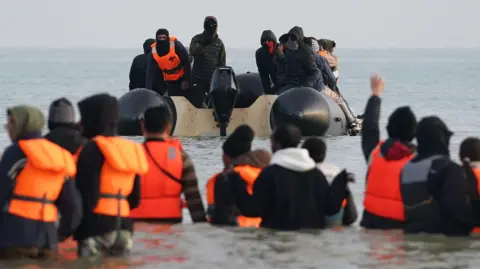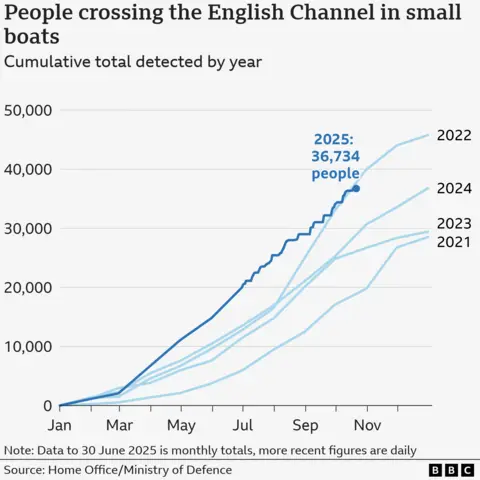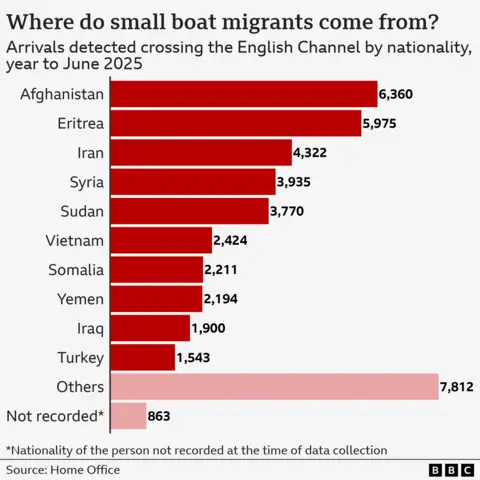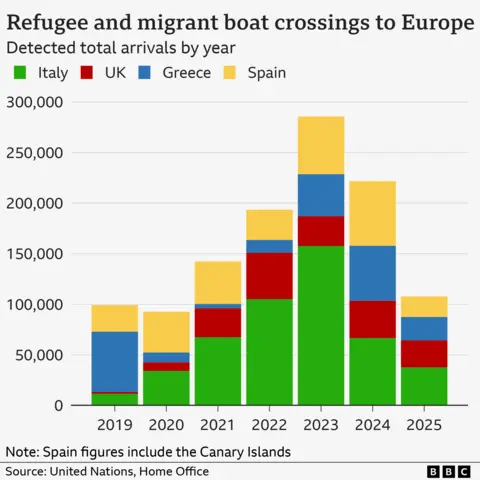 PA Media
PA MediaA migrant who was sent back to France under the government’s “one in, one out” scheme later returned to the UK on another small boat, the BBC understands.
More than 36,000 people have crossed the English Channel in small boats since the start of 2025.
At the Labour Party conference, Prime Minister Sir Keir Starmer committed to “smash” people smuggling gangs and cut the number of crossings by 2029.
How many people cross the Channel in small boats?
As at 21 October, 36,734 people had arrived in the UK by small boat in 2025.
That’s 8,530 more than on the same date in 2024, but 869 lower than at the same point in 2022, the highest year on record.
Just over 45,000 people crossed in 2022.
Many factors, including weather, affect the number of crossings so it is not possible to say whether 2025 will surpass 2022 for the highest number of crossings.

More than 187,000 people have arrived in small boats since figures were first recorded in 2018.
Small boat arrivals are a small percentage of the UK’s overall immigration figure.
In 2024, an estimated 948,000 people arrived expecting to stay at least a year. An estimated 517,000 people left the country.
How many people die crossing the Channel?
The International Organization for Migration (IOM), a UN agency, tracks the number of people who die while attempting to cross the Channel.
It includes those who died in other circumstances while travelling to a crossing point, such as in car crashes or as a result of medical issues.
The IOM estimates that at least 82 migrants died in 2024, making it the deadliest year on record.
As at 22 September it said that at least 20 people had died making a channel crossing in 2025. At least eight more people died while travelling to make the crossing.
Since 2018, at least 257 people have died in connection to a Channel crossing.
The Refugee Council has said that the dangers of crossings have increased, with more people crammed into less seaworthy boats.
How does the ‘one in, one out’ deal work?
 PA Media
PA MediaUnder a year-long pilot scheme which began in August 2025, UK officials can make referrals for returns to France within three days of someone’s arrival by small boat.
French authorities can then identify the same number of asylum seekers currently in France who intend to come to the UK but have not tried to cross.
Those who pass security and eligibility checks can be relocated to the UK and given three months to claim asylum or apply for a visa. They are not allowed to work, study or have access to benefits during this time.
Critics – including the Conservatives – argue the numbers returned to France are likely to be a very small proportion of those crossing.
So far, 42 people who arrived in the UK on small boats have been removed under the scheme.
In October, the Guardian newspaper first reported that one of the earliest migrants to be sent back to France had returned to the UK.
The BBC understands the man is an Iranian national who was initially detained on 6 August and removed on 19 September before coming back on 18 October.
That means he was either the second or third person to be sent to France.
The Home Office declined to confirm the Guardian report, but a spokesperson said a migrant had been detained and their removal was being sought as soon as possible.
What other measures has the government introduced to cut numbers?
In July, the government announced that 25 people including gang leaders and small boat suppliers had had their assets frozen and been banned from travelling to the UK.
An extra 300 National Crime Agency officers will target people-smugglers and a new Border Security Command body will work closely with the Home office, police, immigration enforcement and intelligence agencies.
The UK is also paying France almost £500m over three years – as agreed by the previous Conservative government – to fund extra officers on the French coast.
Toughened rules mean it is now almost impossible for anyone who arrives in the UK on a small boat to become a British citizen.
The charity Asylum Matters has argued for a complete rethink of the government’s asylum policy, saying: “The only way to stop people from making dangerous journeys is to give them real safe routes to seek sanctuary.”
Who is crossing the Channel in small boats?

In the year to June 2025, 88% of all so-called “irregular arrivals” to the UK came across the English Channel.
Of the 111,984 people who claimed asylum in the period, 39% (43,600) arrived this way.
The Home Office can remove people with no legal right to stay in the UK, or refuse to let them enter. But the 1951 Refugee Convention establishes the right to claim asylum in a foreign state if an applicant can prove they face a serious threat to life or freedom in their country of origin.
There are some exceptions for serious criminals who can be legitimately turned away.
In the year ending June 2025, 2,330 people who had arrived by small boat were returned to their home country, 7% fewer than in the previous 12-month period.
The vast majority (75%) were Albanian nationals. Turkish and Iraqi nationals were the two next most common nationalities, together accounting for 12% of small boat returns.
Between 2018 and June 2025, 6,313 people who came to the UK in small boats were returned to their home country – about 4% of the total who arrived this way.
How do UK small boat arrivals compare with those to Europe?
There were almost 189,000 arrivals by sea in Europe during 2024, with Italy receiving more than a third.
Greece and Spain also received large numbers.
As at 10 August, there had been 82,419 arrivals by sea since the start of 2025, with the majority recorded in Italy.

In the year ending September 2024, 1.1 million people claimed asylum in the EU and European Economic Area (EEA), down 3% compared with the previous year.
Germany received the most applicants – 294,415. France was second (162,390) followed by Italy (162,305) and Spain (161,470).



